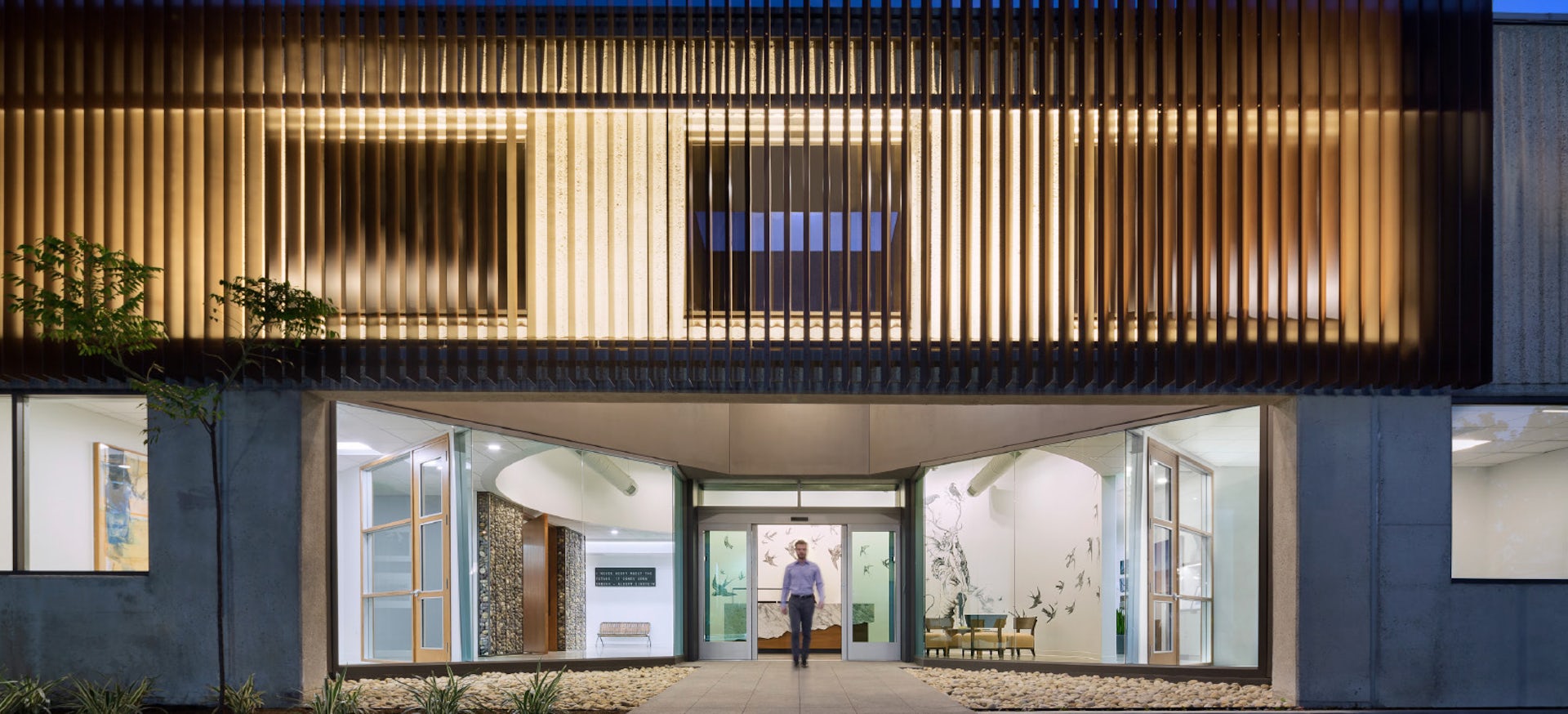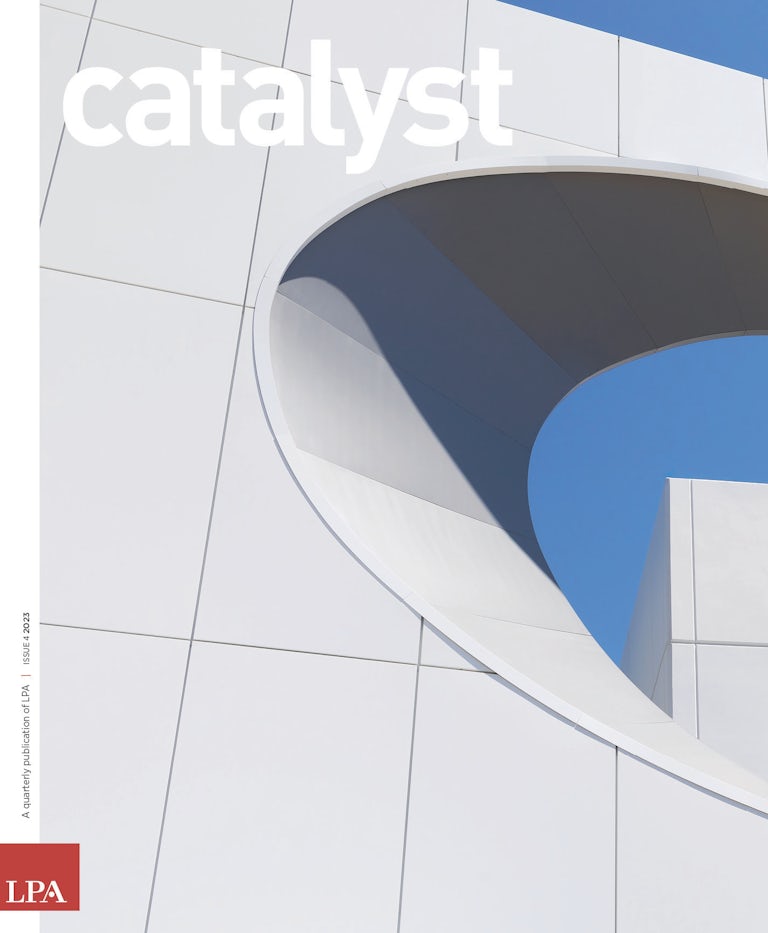We’re broadening our data reporting to help us better analyze energy, water and embodied carbon performance on different types of projects.
By Keith Hempel
President/Chief Design Officer
LPA Design Studios
In recent Catalyst issues, you may have noticed new metrics graphics accompanying project articles.
As often as possible, we’re embracing new tools for sharing our results for energy, lighting, water and embodied carbon to present a more complete picture of a project’s performance.
For years, we’ve included an energy-use-reduction graphic on every project spotlight, but energy is not the only metric driving our work. Different project types require performance targets beyond energy. On renovation and adaptive reuse projects, for example, designers may have limited opportunity to influence the building’s energy performance, but we can still analyze and share our embodied carbon results. We can tell more complete stories around water, materials and healthy environments.
As an integrated firm, our designers, engineers and landscape architects set project goals around a broad definition of sustainability, including experience, wellness and community and performance. Sharing a broader set of data helps us improve and better illustrate what it means to design high-performance projects. At the same time, clearly understood metrics and standards can assist our clients in making smart choices on construction materials, systems, finishes and glazing, which can reduce carbon and save costs.
We’re not alone in making this commitment to sharing our data. The number of projects reporting embodied carbon to the AIA is growing, and performance data is increasingly part of industry awards programs. The AIA is leading efforts to create better industry standards on carbon and materials, addressing the many ways our work impacts people and the environment.
For years, LPA has shared energy performance and pEUI numbers as part of our support for the AIA 2030 Commitment, which seeks to eliminate carbon emissions from new construction by 2030. Each year we share our progress reducing energy use in our projects, based on the 2030 Commitment’s targets. (For 2022, we achieved a 78.7% average reduction across 6.2 million square feet of new construction, aiming for the current 80% target.)
For us, the energy metrics presented by the 2030 Commitment drew the line in the sand and made it clear that if we’re going to talk about a project, we’re going to talk about its performance. But we’ve reached a point where we can be offering a more complete picture of what sustainable design means on different types of projects.
We are employing a variety of tools to help us tell different types of stories. On interior-focused projects, such as fit-outs or modernizations for K-12 or higher ed buildings, we may not have full control of the building envelope or building systems, but we can still measure our performance in several key categories. Lighting power density, for example, helps us illustrate our impact on energy use.
All our projects present opportunities to track progress. Our Sport + Recreation and civic parks teams may not use energy as the key metric, but we can talk about potable water use reduction and embodied carbon in the surfaces and materials. Our landscape architects use the peer-reviewed i-Tree Tools to measure stormwater, carbon sequestration, energy and dollar value impacts of existing and proposed trees.
On all our projects we are growing more sophisticated in our ability to track water, which is a critical issue in many areas where we work. For the net-zero-energy Tracy Recreation Center, we were able to determine that limiting natural grass, using subsurface irrigation and focusing on low-water-use native plants could help reduce the water use 58% from the existing baseline.
While lighting and water tracking have been available for years, new tools are helping us do a better job of tracking our carbon impact. One is the EPIC (Early Phase Integrated Carbon Assessment) tool developed by EHDD, which is a free online calculator that considers the project’s whole-life carbon impact with data that can be used early in the design process. We are also using Architecture 2030’s CARE (Carbon Avoided: Retrofit Estimator) tool, which specifically focuses on building re-use. Our site teams use the Climate Positive Design Pathfinder tool to measure embodied carbon and sequestration with our sites. The report measures when the plants and trees on the project will sequester more carbon than is emitted during the construction and maintenance phase, a “years to positive” number.
As an industry, we’re still working on developing widely accepted baselines for measuring carbon in projects. But these new tools can help us analyze options and gauge their impact on climate change, a project’s efficiency of a project and the cost benefits for clients.
Both the EPIC and CARE tools generate a total carbon emission metric, including operational and embodied carbon, which is a good place to start to help designers better understand their decisions. For a long time, many tools focused either on operational or embodied; a total carbon number gets us talking about the right targets, considering the challenges ahead of us. If we’re having a meaningful conversation on limiting carbon emissions through the built environment, then we really need to understand total carbon.
On every project, we’re taking a more holistic view of measuring what success means. Our commitment is to solve for sustainability on every project, regardless of scope, scale or budget.
For us, that means every design should have easily shared metrics that help us and our clients understand performance and the value proposition of projects that are more resilient, conserve water and energy, and reduce carbon emissions.
Keith Hempel is President of LPA Design Studios. In 2021, he was elevated to the American Institute of Architects’ College of Fellows in recognition of his significant national contributions to the architecture profession.
















